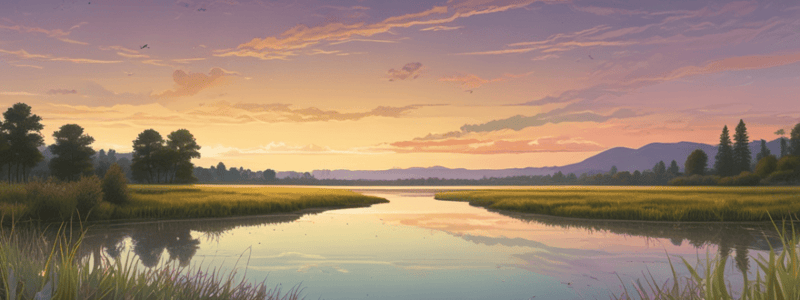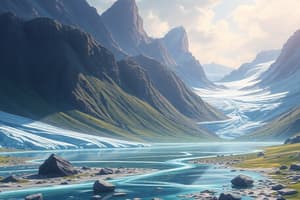Podcast
Questions and Answers
What ecological significance do lacustrine wetland systems have in terms of nutrient cycling?
What ecological significance do lacustrine wetland systems have in terms of nutrient cycling?
- They act as sources of nutrients such as nitrogen and phosphorus
- They act as sinks for nutrients such as nitrogen and phosphorus (correct)
- They only interact with nitrogen but not phosphorus
- They have no significant role in nutrient cycling
What is the significance of lacustrine wetland systems in terms of carbon sequestration?
What is the significance of lacustrine wetland systems in terms of carbon sequestration?
- They have no role in carbon cycling
- They release carbon dioxide into the atmosphere
- They only sequester carbon in soil and sediments
- They capture carbon dioxide through photosynthesis (correct)
What role do lacustrine wetlands play in regulating the hydrological cycle?
What role do lacustrine wetlands play in regulating the hydrological cycle?
- They accelerate the hydrological cycle
- They have no impact on the hydrological cycle
- They only recharge groundwater during dry periods
- They regulate the hydrological cycle by storing and releasing water (correct)
What is the significance of lacustrine wetland systems in terms of biodiversity?
What is the significance of lacustrine wetland systems in terms of biodiversity?
Why are lacustrine wetlands important for habitat conservation?
Why are lacustrine wetlands important for habitat conservation?
What role do lacustrine wetlands play in shoreline stabilization and erosion control?
What role do lacustrine wetlands play in shoreline stabilization and erosion control?
What cultural significance do lacustrine wetland systems have for indigenous communities?
What cultural significance do lacustrine wetland systems have for indigenous communities?
What is a crucial aspect of lacustrine wetland systems in terms of nutrient cycling?
What is a crucial aspect of lacustrine wetland systems in terms of nutrient cycling?
Why is accurate boundary delineation essential for environmental impact assessments?
Why is accurate boundary delineation essential for environmental impact assessments?
What is a key function of lacustrine wetland systems in terms of hydrology?
What is a key function of lacustrine wetland systems in terms of hydrology?
Why is accurate boundary delineation necessary for regulatory compliance?
Why is accurate boundary delineation necessary for regulatory compliance?
What is a consequence of inaccurate boundary delineation in lacustrine wetland systems?
What is a consequence of inaccurate boundary delineation in lacustrine wetland systems?
What is a benefit of accurate boundary delineation for habitat conservation?
What is a benefit of accurate boundary delineation for habitat conservation?
Why is accurate boundary delineation essential for maintaining water quality in lacustrine wetland systems?
Why is accurate boundary delineation essential for maintaining water quality in lacustrine wetland systems?
What is the primary purpose of delineating the boundaries of lacustrine wetland systems?
What is the primary purpose of delineating the boundaries of lacustrine wetland systems?
What is the main characteristic that distinguishes lacustrine wetland systems from other wetland types?
What is the main characteristic that distinguishes lacustrine wetland systems from other wetland types?
What is the primary function of ecotones in lacustrine wetland systems?
What is the primary function of ecotones in lacustrine wetland systems?
What is the impact of extended droughts on lacustrine wetland systems?
What is the impact of extended droughts on lacustrine wetland systems?
What is the primary influence on the boundaries of the littoral zone in lacustrine wetland systems?
What is the primary influence on the boundaries of the littoral zone in lacustrine wetland systems?
What is the primary ecological significance of lacustrine wetland systems?
What is the primary ecological significance of lacustrine wetland systems?
What is the impact of human activities on lacustrine wetland systems?
What is the impact of human activities on lacustrine wetland systems?
What is a crucial aspect of resource management in lacustrine wetland systems?
What is a crucial aspect of resource management in lacustrine wetland systems?
In conservation efforts, what is the primary benefit of accurate delineation of lacustrine wetland systems?
In conservation efforts, what is the primary benefit of accurate delineation of lacustrine wetland systems?
What is the significance of accurate boundary delineation in research and monitoring of lacustrine wetland systems?
What is the significance of accurate boundary delineation in research and monitoring of lacustrine wetland systems?
What is a primary concern in managing recreational activities in lacustrine wetland systems?
What is a primary concern in managing recreational activities in lacustrine wetland systems?
Why is it important to have precise boundary information in wetland restoration projects?
Why is it important to have precise boundary information in wetland restoration projects?
What is a key benefit of accurate delineation of lacustrine wetland systems in terms of habitat conservation?
What is a key benefit of accurate delineation of lacustrine wetland systems in terms of habitat conservation?
Why is it crucial to have accurate boundaries in lacustrine wetland systems for sustainable management of fisheries?
Why is it crucial to have accurate boundaries in lacustrine wetland systems for sustainable management of fisheries?
What is a key application of accurate boundary delineation in lacustrine wetland systems?
What is a key application of accurate boundary delineation in lacustrine wetland systems?
What is the significance of accurate boundary delineation in responding to ecological pressures such as climate change and invasive species?
What is the significance of accurate boundary delineation in responding to ecological pressures such as climate change and invasive species?
Study Notes
Ecological Significance of Lacustrine Wetland Systems
- Lacustrine wetland systems support diverse ecosystems and harbor a wide variety of plant and animal species.
- They provide habitats for aquatic organisms such as fish, amphibians, reptiles, invertebrates, and aquatic plants.
- The surrounding riparian zones and wetland habitats support terrestrial species, including mammals, birds, and insects.
- These diverse habitats contribute to high levels of biodiversity and serve as important refuges for many species.
Habitat for Endemic and Threatened Species
- Lacustrine wetlands often harbor endemic species that are found nowhere else, as well as populations of threatened and endangered species.
- These habitats provide critical breeding, feeding, and nesting grounds for species with specialized ecological requirements.
- Protection and restoration of lacustrine wetlands are essential for conserving these unique and vulnerable species and maintaining overall biodiversity.
Nutrient Cycling and Water Quality
- Lacustrine wetlands play a crucial role in nutrient cycling and water quality maintenance.
- They act as sinks for nutrients such as nitrogen and phosphorus, which are essential for plant growth but can lead to eutrophication and water quality degradation when present in excess.
- Wetland vegetation and soils help absorb and trap these nutrients, preventing them from entering the water column and reducing the risk of algal blooms and oxygen depletion.
Carbon Sequestration and Storage
- Lacustrine wetland systems contribute to global carbon cycling by sequestering and storing carbon in vegetation, soil, and sediments.
- Aquatic plants capture carbon dioxide from the atmosphere through photosynthesis, incorporating carbon into biomass.
- This carbon storage helps mitigate climate change by removing carbon dioxide from the atmosphere and reducing greenhouse gas emissions.
Hydrological Regulation and Flood Control
- Lacustrine wetlands play a crucial role in regulating the hydrological cycle and mitigating the impacts of floods and droughts.
- Lakes act as natural reservoirs, storing water during periods of high precipitation and releasing it gradually during dry periods.
- Wetlands surrounding lakes help absorb excess water during floods, reducing peak flows and preventing downstream flooding.
- These wetlands also recharge groundwater and maintain base flow in rivers and streams during dry periods, ensuring water availability for ecosystems and human communities.
Shoreline Stabilization and Erosion Control
- Lacustrine wetland systems provide important shoreline stabilization and erosion control services.
- Vegetation along lake shores helps bind soil and stabilize banks, reducing erosion caused by waves and currents.
- Wetland vegetation also acts as a buffer, dissipating wave energy and protecting adjacent coastal areas from erosion and sedimentation.
Cultural and Recreational Values
- Lacustrine wetland systems hold cultural and recreational significance for communities.
- These ecosystems provide opportunities for fishing, boating, swimming, birdwatching, hiking, and other outdoor activities, enhancing the quality of life for residents and attracting tourists.
- Additionally, lakes often have cultural importance for indigenous communities, who may rely on them for food, water, transportation, and spiritual connection.
Accurate Delineation of Lacustrine Wetland System Boundaries
- Accurate boundaries are necessary for complying with national and international wetland protection laws.
- Clear boundaries facilitate the issuance of permits for activities such as development, agriculture, and industrial operations, ensuring that they do not encroach on protected wetland areas.
- Accurate delineation informs zoning regulations and guides sustainable development practices, helping planners and developers avoid environmentally sensitive areas and reduce the risk of legal disputes.
Cowardin Wetland Classification
- The Cowardin classification system defines the boundaries or limits of lacustrine wetland systems based on specific criteria related to size, depth, vegetation, and other physical characteristics.
- These boundaries are crucial for accurately identifying, classifying, and managing lacustrine wetland systems.
Boundaries of Lacustrine Wetland Systems
- Size and Area Boundary: Lacustrine wetland systems include water bodies that are larger than 8 hectares (20 acres) in size or have a fetch greater than 500 meters (1,640 feet).
- Depth Boundary: Lacustrine wetlands are characterized by water depths greater than 2 meters (6.6 feet) at low water.
- Water Level Boundary: The boundary is often defined by the ordinary high water mark, which can be identified by physical characteristics such as natural lines on the shore, changes in soil composition, and the presence of certain types of vegetation.
- Shoreline Boundary: The shoreline is typically well-defined and includes features such as beaches, cliffs, or gradual slopes leading into deeper waters.
- Vegetation Boundary: Lacustrine wetland systems typically lack persistent emergent vegetation in their central open water areas.
- Dams and Impoundments Boundary: Human-made lakes or reservoirs created by damming rivers or streams are included if they meet the size and depth criteria for lacustrine systems.
Ecotones of Lacustrine Wetland Systems
- Ecotones in lacustrine wetland systems are transition zones where freshwater lakes and surrounding terrestrial ecosystems meet, creating diverse and ecologically significant habitats.
- Lacustrine wetlands encompass a variety of habitats, including lake shores, wet meadows, and shallow water zones, and support a wide range of plant and animal species.
- Ecotones within these systems play important roles in nutrient cycling, habitat provision, and shoreline stability.
Factors Influencing Boundaries of Lacustrine Wetland Systems
- Seasonal Variability: Water levels rise and fall with the seasons, affecting the extent of lacustrine wetland systems.
- Climate and Weather Events: Extended droughts or heavy rainfall and flooding can alter the size and shape of lacustrine wetland systems.
- Human Activities: Dam construction, water withdrawal, and urban development can alter the size and shape of lacustrine wetland systems.
- Geomorphological Changes: Natural processes such as erosion and sediment deposition can change the boundaries of lacustrine wetland systems.
- Biological Factors: The extent of emergent and submergent vegetation can influence the boundaries of the littoral zone of lacustrine wetland systems.
Studying That Suits You
Use AI to generate personalized quizzes and flashcards to suit your learning preferences.
Related Documents
Description
Lacustrine wetland systems support diverse ecosystems and harbor a wide variety of plant and animal species. They provide habitats for aquatic and terrestrial organisms, making them biodiversity hotspots.

